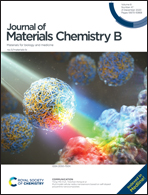A carbazole functionalized semiconducting compound as a heavy atom free photosensitizer for phototherapy against lung cancer†
Abstract
Semiconducting compounds with high photostability and excellent photothermal ability are potential candidates for phototheranostics. In this paper, the heavy atom free compound 3,6-bis(5-(4-(9H-carbazol-9-yl)phenyl)furan-2-yl)-2,5-bis(2-octyldodecyl)pyrrolo[3,4-c]pyrrole-1,4(2H,5H)-dione (denoted as DPPCz) has been designed and synthesized through a C–H activation coupling reaction. DPPCz has a high singlet oxygen quantum yield (1O2 QY) of 40.3% in DCM. In addition, DPPCz NPs obtained by nanoprecipitation exhibit a high photothermal conversion efficiency (48.2%) in water. DPPCz NPs have a low half inhibitory concentration (IC50) of 7.1 μg mL−1 towards human lung cancer cells (A549) with irradiation while the dark toxicity is almost negligible even at high concentrations. Furthermore, in vivo photothermal imaging guided study demonstrates that these NPs are able to inhibit tumor growth with the help of laser. The H&E stained pictures of the normal tissues indicate the biosafety of DPPCz NPs in that no obvious damage was observed. Our results demonstrate that DPPCz NPs are potential semiconducting photosensitizers for phototheranostics.

- This article is part of the themed collection: Journal of Materials Chemistry B HOT Papers


 Please wait while we load your content...
Please wait while we load your content...